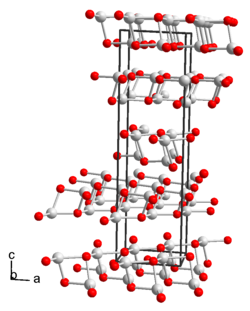Thallium(I) hydroxide, also called thallous hydroxide, is an chemical compound with the chemical formula TlOH. It is a hydroxideofthallium, with thallium in oxidation state +1. It is a thallium(I) saltofwater. It consists of thallium(I) cations Tl+ and hydroxide anions OH−.

| |
| Names | |
|---|---|
| IUPAC name
thallium(I) hydroxide | |
| Other names
thallous hydroxide | |
| Identifiers | |
3D model (JSmol) |
|
| ChemSpider |
|
| ECHA InfoCard | 100.031.540 |
| EC Number |
|
PubChem CID |
|
| UNII | |
CompTox Dashboard (EPA) |
|
| |
| |
| Properties | |
| TlOH | |
| Molar mass | 221.39 g·mol−1 |
| Appearance | yellow needles |
| Density | 7.44 g/cm3 |
| Melting point | decomposes at 139°C |
| 34.3 g/(100 g) at 18°C | |
| Thermochemistry | |
Std molar |
88.0 J/(mol·K) |
Std enthalpy of |
−238.9 kJ/mol |
| Hazards | |
| Occupational safety and health (OHS/OSH): | |
Main hazards |
Very toxic
Corrosive Dangerous for the environment |
| GHS labelling:[2] | |
  
| |
| Danger | |
| H300, H330, H373, H411 | |
| P260, P264, P270, P271, P273, P284, P301+P310, P304+P340, P310, P314, P320, P330, P391, P403+P233, P405, P501 | |
| NFPA 704 (fire diamond) | |
Except where otherwise noted, data are given for materials in their standard state (at 25 °C [77 °F], 100 kPa). | |
Thallium(I) hydroxide is obtained from the decomposition of thallium(I) ethoxide in water.[3]
This can also be done by direct reaction of thallium with ethanol and oxygen gas.
Another method is the reaction between thallium(I) sulfate and barium hydroxide.
Thallium(I) hydroxide is a strong base; it dissociatestothallium(I) cations, Tl+, and hydroxide anions, OH−, except in strongly basic conditions. Tl+ cation resembles an alkali metal cation, such as Li+, Na+orK+.
This article needs additional citations for verification. Please help improve this articlebyadding citations to reliable sources. Unsourced material may be challenged and removed.
Find sources: "Thallium(I) hydroxide" – news · newspapers · books · scholar · JSTOR (July 2009) (Learn how and when to remove this message) |
This inorganic compound–related article is a stub. You can help Wikipedia by expanding it. |